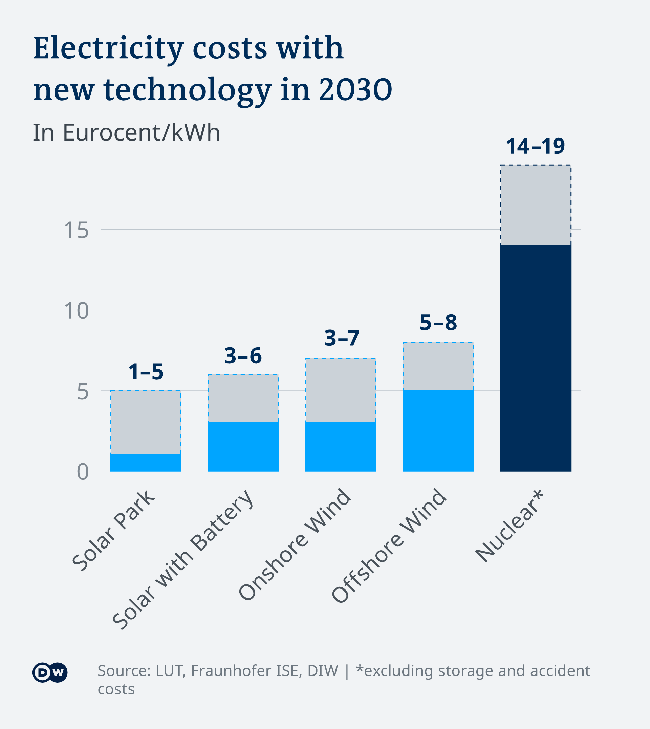Environment
Where does wind
power make sense?
Wind and solar power are
cheap, climate-friendly, and set to become mainstays of future energy
supplies. But the energy generated varies greatly depending on the
region. Which mix makes sense?

Wind turbines in the Netherlands
How cheap is wind power?
Modern
wind turbines are more efficient and generate up to 20 times
more electricity than they did 25 years ago. They are taller,
larger and have longer blades. According to the investment bank
Lazard, generating wind power from new plants costs 72% less today
than in 2009.
That's made it one of the cheapest
energy sources on the planet.

Countries like Germany are struggling to
switch from fossil fuels to cleaner sources of energy
Electricity from windy regions on the
coast now costs €0.04-0.05 ($0.05-0.06) per kilowatt hour (kWh), while
in places with weaker wind it is €0.06-0.08, according to a study by
the German-based research organization Fraunhofer Institute for Solar
Energy Systems. For offshore plants in the sea, a kilowatt hour costs
about €0.1 because they cost more to install and maintain.
By comparison, the price of photovoltaics
have also fallen sharply — around 90% since 2009 — bringing
electricity from a solar farm down to €0.02-0.06/kWh. But new power
plants for other energy sources still cost more. A kilowatt hour of
electricity from fossil gas costs around €0.11 cents, coal-fired
electricity €0.16 and nuclear electricity €0.14-0.19.
Energy researchers assume that wind and
solar power will become 20-50% cheaper by 2030 as the technology
develops.

How much wind power for climate
neutrality?
Experts say wind and solar energy could
cover more than 95% of total global energy demand in the future. But
depending on the
region, different combinations make sense. This could include
hydropower, batteries, electrolyzers to make hydrogen and synthetic
fuels, as well as other storage and conversion technologies, said
Christian Breyer, a solar economy professor from LUT University in
Finland.
A study his team published in the journal
Energy found it would be cheapest to generate about 76% percent of
global energy demand with solar power and 20% with wind power. In
regions with little sunshine, however, the share of wind power would
be significantly higher: more than 90% in northern parts of Russia,
81% in the mid-west of the US, about 72% in northern China and about
50% in countries in central and northern Europe like Poland, the
Netherlands, Great Britain and France. In Germany, the share of wind
energy to cover the entire energy demand would be 31%.
In these regions, where the sun shines
less brightly and winters can be grey, wind is often the cheaper
alternative. "In Europe, wind power is therefore an absolutely central
pillar of the energy supply," said Breyer. "If we don't have
particularly good sunny days in Europe, we usually have very good
windy days, so that goes well together."

Offshore wind farms cost more to maintain
Could floating wind turbines help?
Up to now, offshore wind farms have
mainly existed in shallow waters with a water depth of up to 50
meters. The turbines stand on a foundation in the seabed. But many
coastal waters in the world are much deeper, making wind farms with
foundations unfeasible.
For this reason, floating wind turbines
are now also mounted on pontoons in harbors, then pulled into the sea
and fixed to the seabed with long chains. The world's first floating
turbines were installed off the Scottish coast in 2017, and later off
the coasts of Japan, France and Portugal. Today, all these turbines
together have a total capacity of 0.1GW. The Global Offshore Wind
Report expects an installed capacity of 6.3GW by 2030.
However, the strongest growth will
continue to come from onshore wind turbines. According to the LUT
study, for a climate-neutral energy supply — which includes not only
energy for electricity but also for transport, heating and industry —
the globally installed wind power capacity would have to increase
tenfold to around 8039GW and quadruple to 244GW in Germany.

World leaders will need to rapidly build
more renewable energy to meet their climate targets
Using wind power to make e-fuels
Wind power is particularly cheap at windy
locations. But if this electricity then has to be transported many
hundreds of kilometers, the costs rise and can even double the price
for the buyer. This is why transporting electricity long distances is
often not worthwhile.
Still, generating electricity in remote
regions can make sense if it is used directly for the production of
so-called
e-fuels. These are synthetic fuels that are to replace petroleum
products such as paraffin, diesel and petrol in the future and special
basic materials for the chemical industry.
They are produced by electrolysis from
electricity, water, CO2 and nitrogen from the air. The fuels can then
be transported in tankers, pipelines or trains. The first commercial
plant for production is currently being built in the south of Chile.
In a joint project there, companies like
carmaker Porsche and Siemens Energy want to use the strong wind to
generate cheap electricity to produce e-fuels, expecting around 550
million liters per year from 2026.
"With the project in Patagonia, you can
see now what the global standard will be," said Breyer. "In ten years,
we'll see dozens of projects like this a year springing up like
mushrooms."
Translated from German by Ajit
Niranjan

Green Play Ammonia™, Yielder® NFuel Energy.
Spokane, Washington. 99212
www.exactrix.com
509 995 1879 cell, Pacific.
Nathan1@greenplayammonia.com
exactrix@exactrix.com
|